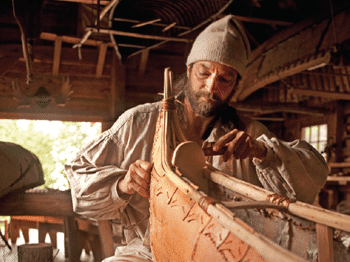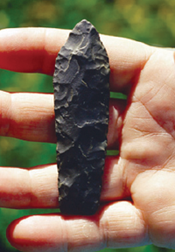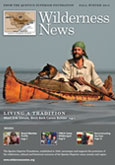The Fall-Winter Issue of Wilderness News is in the mail and online.
COVER STORY:
Meet Erik Simula Birch Bark Canoe Builder
By Alissa Johnson

For twenty years, Erik Simula has lived almost exclusively off the grid near the Minnesota and Canadian border. He hasn’t had a refrigerator or a freezer, and bringing home the groceries has meant using a team of sled dogs to haul them over snow. “For most of my life, I could never drive to my cabin,” Erik says. He counts moose, red fox, gray jays, and even bears among his neighbors. “I have a pet moose just like anyone that lives way out.” During the summer, the sled dogs run loose and Erik builds birch bark canoes—he has completed 16 and has four in progress. Come fall he hunts, nets fish, and harvests wild rice. He has slept in teepees, shacks, shanties, and spent more than a few nights under an overturned canoe. “I have lived, many different times, for long durations isolated from people, and I never really get lonely,” Erik explains. “I’ve always sought to have isolation for the peace and solitude. I’ve never been bored in my life here, nature provides that stimulus for me.” Read On >
North House Folk School’s Instructor-in-Residence Program
The North House Folk School is a school of traditional craft—students can learn everything from knitting or making soap to boat building or timber framing. Located on the edge of Lake Superior in Grand Marais, Executive Director Greg Wright explains that it’s all about telling a story. Read On >
Meet Stewart Crosby
Quetico Superior Foundation Board Member Profile Read On >
YMCA Camp Widjiwagan: Generations of Exploration
By Greg Seitz

On the pine-covered shores of Burntside Lake’s North Arm twenty miles northeast of Ely, Camp Widjiwagan has been a launching point for teenagers to explore wilderness since 1929. Today, some families are sending their fourth generation of campers to Widji, where the fundamental experience hasn’t changed much since their grandparents’ days. The camp still uses the wood-canvas canoes, still keeps the groups small, and still teaches kids to respect themselves, their equipment, and the wilderness. Read On >
Reconstructing the Past
By Rob Kesselring

Archaeologists are painting a picture of Quetico-Superior’s first people and what the land looked like 12,000 years ago… It has been believed that the Quetico-Superior wilderness after being cloaked, scraped clean, and flooded by the last glacial advance was, for a long span of time, too inhospitable for human habitation, but recent research indicates otherwise. It now appears that people followed the retreating ice like ticks on a moose… Read On >


